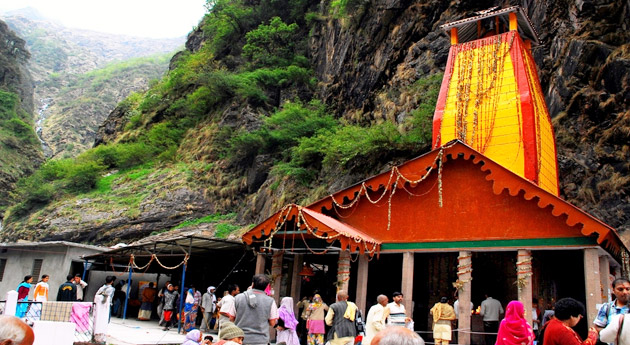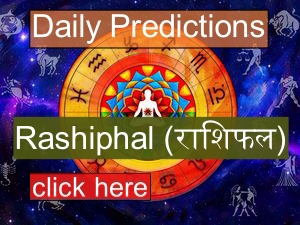Yamunotri Dham

On the western side of Garhwal Himalayas, in the Uttarkashi district of Uttarakhand, lies the holy place of Yamunotri. About 3,293 metres above the sea level, Yamunotri stands proudly with its enormous mountain peaks, glaciers and gushing waters of Yamuna. River Yamuna, the second most sacred river of India, originates in Yamunotri, making it one of the pilgrimage sites in the Chota Char Dham Yatra in Uttarakhand.
The venerated goddess Yamuna is said to be the daughter of Sun and twin sister of Yama (the god of death); in Vedas, Yamuna is called Yami (lady of life). A bath in the sanctified waters of Yamuna is said to cleanse all sins and protect from untimely or painful death. Such strong associations in Hindu mythology place Yamuna Devi (goddess) in high ranks of divinity.
On the western side of Garhwal Himalayas, in the Uttarkashi district of Uttarakhand, lies the holy place of Yamunotri. About 3,293 metres above the sea level, Yamunotri stands proudly with its enormous mountain peaks, glaciers and gushing waters of Yamuna. River Yamuna, the second most sacred river of India, originates in Yamunotri, making it one of the pilgrimage sites in the Chota Char Dham Yatra in Uttarakhand.
The venerated goddess Yamuna is said to be the daughter of Sun and twin sister of Yama (the god of death); in Vedas, Yamuna is called Yami (lady of life). A bath in the sanctified waters of Yamuna is said to cleanse all sins and protect from untimely or painful death. Such strong associations in Hindu mythology place Yamuna Devi (goddess) in high ranks of divinity.
The River Yamuna originates from the Yamunotri glacier, which rises up to 6,315 meters above sea level, and lies against a steep slope just below the top of the Kalind peak. From here Yamuna comes down into Saptarishi Kund and from there gushes southwards in a series of waterfalls. To the west of the Kalind Parbat is located Banderpoonch, which is a dominant mountain in central Himalayan area of Garhwal and divides the watershed of Yamuna from that of the Ganges. Coming out from Kalind Parbat, Yamuna is also known as Kalindi.
As per a legend, Lord Hanuman doused the fire of his tail after burning Ravan's Lanka in the chilly waters of Yamuna at Banderpooch. That is why the peak is called Bander (monkey) Pooch (tail) - monkey's tail. Another legend sees Yamunotri as the hermitage of ancient sage Asit Muni. The Muni used to bath both in Yamuna and Ganga, but in his old age he couldn't travel to Gangotri. Realising his problem, a stream of Ganga started to flow beside that of Yamuna.
Haridwar - Gateway to Gods

A paradise for nature-lovers, Haridwar presents kaleidoscope of Indian culture and civilization. Haridwar also termed as 'Gateway to Gods' is known as Mayapuri, Kapila, Gangadwar as well. The followers of Lord Shiva and followers of Lord Vishnu pronounce this place Hardwar and Hardwar respectively as told by some. It is also a point of entry to Dev Bhoomi and Char Dham. Badrinath, Kedarnath, Gangotri and Yamunotri.
Haridwar is also one of the four places; where Kumbh Mela occurs after rotation of every twelve Years and Ardh Kumbh after every six years. It is said that drops of Amrit (Elixir) fell in to the Brahmkund of Har-Ki-Pairi, therefore considered that a dip in the Brahmakund on this particular day which is very auspicious and when Jupiter (Brahaspati) comes to the sign Aquarius (Kumbh) once in every twelve years the Maha Kumbh fair is celebrated at Haridwar.
Haridwar has not only remained the abode of the weary in body, mind and spirit, but also served as centre of attraction for many, for learning the arts science, culture and spirituals. Haridwar's long standing position as a great source for spirituals, yoga, Ayurvedic, medicines and herbal remedies as well as its unique Gurukul school of traditional education, the scenic beauty and lush greenery... all give the city unique flavors and charm; a must among the sojourn centers in a discoverer's intinary of Uttarakhand - A destination for all seasons.
Haridwar Tourist Spot Are:
Har Ki Pauri, Chandi Devi Temple, Mansa Devi Temple, Maya Devi Temple, Kankhal, Piran Kaliyar, Neel Dhara Pakshi Vihar, Bhimgoda Tank, Ram Mandir, Doodhadhari Barfani Temple, Sureshvari Devi Temple, Pawan Dham, Bharat Mata Mandir, Jairam Ashram, Sapt Rishi Ashram and Sapt Sarovar, Parad Shivling, Ramanand Ashram, Anandamayi Maa Ashram, Shantikunj etc.
Varanasi

Varanasi, also known as Benares or Kashi, is a city on the banks of the Ganges in the Uttar Pradesh state of North India. As a spiritual capital of India, it is the holiest of the seven sacred cities (Sapta Puri) in Hinduism and Jainism, and played an important role in the development of Buddhism. Varanasi lies along National Highway 2, which connects it to Kolkata, Kanpur, Agra, and Delhi, and is served by Varanasi Junction and Lal Bahadur Shastri International Airport.
The city grew as an important industrial centre, famous for its muslin and silk fabrics, perfumes, ivory works, and sculpture. Buddha is believed to have founded Buddhism here around 528 BC when he gave his first sermon, "The Setting in Motion of the Wheel of Dharma", at nearby Sarnath. The city's religious importance continued to grow in the 8th century, when Adi Shankara established the worship of Shiva as an official sect of Varanasi.
Varanasi remained the centre of activity for Hindu intellectuals and theologians during the Middle Ages, which further contributed to its reputation as a cultural centre of religion and education. Tulsidas wrote his epic poem on Rama's life called Ram Charit Manas in Varanasi. Several other major figures of the Bhakti movement were born in Varanasi, including Kabir and Ravidas. Guru Nanak Dev visited Varanasi for Shivratri in 1507, a trip that played a large role in the founding of Sikhism. In the 16th century, Varanasi experienced a cultural revival under the Muslim Mughal emperor Akbar who invested in the city, and built two large temples dedicated to Shiva and Vishnu, though much of modern Varanasi was built during the 18th century, by the Maratha and Bhumihar kings. The kingdom of Benares was given official status by the Mughals in 1737, and continued as a dynasty-governed area until Indian independence in 1947.
The Ramnagar Fort, near the eastern bank of the Ganges, was built in the 18th century in the Mughal style of architecture with carved balconies, open courtyards, and scenic pavilions. Among the estimated 23,000 temples in Varanasi are Kashi Vishwanath Temple of Shiva, the Sankat Mochan Hanuman Temple, and the Durga Temple. The Kashi Naresh (Maharaja of Kashi) is the chief cultural patron of Varanasi, and an essential part of all religious celebrations. An educational and musical centre, many prominent Indian philosophers, poets, writers, and musicians live or have lived in the city, and it was the place where the Benares Gharana form of Hindustani classical music was developed.
Varanasi has been a cultural centre of North India for several thousand years, and is closely associated with the Ganges. Hindus believe that death in the city will bring salvation, making it a major centre for pilgrimage. The city is known worldwide for its many ghats, embankments made in steps of stone slabs along the river bank where pilgrims perform ritual ablutions. Among prominent ones are the Dashashwamedh Ghat, the Panchganga Ghat, the Manikarnika Ghat and the Harishchandra Ghat, the last two being where Hindus cremate their dead.
Places of Attraction
Jantar Mantar
The Jantar Mantar observatory, constructed in 1737, is located above the ghats along the Ganges, and is adjacent to the Manmandir and Dasaswamedh Ghats and near the palace of Raja Jai Singh of Jaipur. While less equipped than the observatories at Jaipur and Delhi, the Jantar Mantar has a unique equatorial sundial which is functional and allows measurements to be monitored and recorded by one person.
Ramnagar Fort
The Ramnagar Fort, located near the Ganges on its eastern bank and opposite the Tulsi Ghat, was built in the 18th century by Kashi Naresh Raja Balwant Singh with cream-coloured chunar sandstone. The fort is a typical example of the Mughal architecture with carved balconies, open courtyards, and scenic pavilions.
The fort and its museum are the repository of the history of the kings of Benares. Cited as an "eccentric" museum, it contains a rare collection of vintage cars, bejewelled sedan chairs, an impressive weaponry hall, and a rare astrological clock. In addition, manuscripts, especially religious writings, are housed in the Saraswati Bhawan which is a part of a museum within the fort. Many books illustrated in the Mughal miniature style are also part of the collections.
Dashashwamedh Ghat
The Dashashwamedh Ghat is the main and probably the oldest ghat of Varanasi located on the Ganges, close to the Kashi Vishwanath Temple. Above and adjacent to this ghat, there are also temples dedicated to Sulatankesvara, Brahmesvara, Varahesvara, Abhaya Vinayaka, Ganga (the Ganges), and Bandi Devi, which are all important pilgrimage sites. A group of priests perform "Agni Pooja" (Worship of Fire) daily in the evening at this ghat as a dedication to Shiva, Ganga, Surya (Sun), Agni (Fire), and the entire universe. Special aartis are held on Tuesdays and on religious festivals.
Manikarnika Ghat
The Manikarnika Ghat is the Mahasmasana, the primary site for Hindu cremation in the city. Adjoining the ghat, there are raised platforms that are used for death anniversary rituals. According to a myth it is said that an earring of Shiva or his wife Sati fell here. Fourth-century Gupta period inscriptions mention this ghat.
Jain Ghat
Varanasi is believed to be the birthplace of Suparshvanatha (7th tirthankara) and Parshvanatha (23rd tirthankara). The Jain Ghat or Bachraj Ghat is a Jain Ghat and has three Jain Temples located on the banks of the River. It is believed that the Jain Maharajas used to own these ghats. Bachraj Ghat has three Jain temples near the river's banks and one them is a very ancient temple of Tirthankara Suparswanath.
Kashi Vishwanath Temple
The Kashi Vishwanath Temple is one of the 12 Jyotirlinga Shiva temples in Varanasi. The temple, which is also known as the Golden Temple, was built in 1780 by Queen Ahilyabai Holkar of Indore. The two pinnacles of the temple are covered in gold and were donated in 1839 by Ranjit Singh, the ruler of Punjab. Numerous rituals, prayers, and aartis are held daily at the temple.
Sankat Mochan Hanuman Temple
The Sankat Mochan Hanuman Temple, which is situated by the Asi River, is one of the sacred temples of the Hindu god Hanuman. According to Hindu legend the temple was built on the spot where the medieval Hindu saint Tulsidas had a vision of Hanuman.
Local Events
On Mahashivaratri (February), a procession of Shiva proceeds from the Mahamrityunjaya Temple to the Kashi Vishwanath Temple. Dhrupad Mela is a five-day musical festival devoted to dhrupad style held at Tulsi Ghat in February–March. The Sankat Mochan Hanuman Temple celebrates Hanuman Jayanti (March–April), the birthday of Hanuman. A special puja, aarti, and a public procession is organised. Since 1923, the temple has organised a five-day classical music and dance concert festival named Sankat Mochan Sangeet Samaroh, when iconic artists from all parts of India are invited to perform.
The Ramlila of Ramnagar is a dramatic enactment of Rama's legend, as told in Ramacharitamanasa. The plays, sponsored by Kashi Naresh, are performed in Ramnagar every evening for 31 days. On the last day, the festivities reach a crescendo as Rama vanquishes the demon king Ravana. Kashi Naresh Udit Narayan Singh started this tradition around 1830.
Nag Nathaiya
Nag Nathaiya is celebrated on the fourth lunar day of the dark fortnight of the Hindu month of Kartik (October–November). It commemorates the victory of Krishna over the serpent Kaliya. On this occasion, a large Kadamba tree branch is planted on the banks of the Ganges so that a boy, playing the role of Krishna, can jump into the river on to the effigy representing Kaliya. He stands over the effigy in a dancing pose playing the flute, while an audience watches from the banks of the river or from boats.
Ganga Mahotsav
Ganga Mahotsav is a five-day music festival organised by the Uttar Pradesh Tourism Department, held in November–December. It culminates a day before Kartik Poornima, also called the Ganges festival. On this occasion the Ganges is attended by thousands of pilgrims, release lighted lamps to float in the river from the ghats.
Comments
No posts found
































